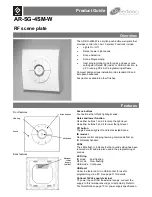
Asentria SiteBoss 530 User Manual
73
IP Address Restrictions
IP Address Restrictions is the primary defense against unauthorized access via a network or PPP connection. An
administrator can restrict access by configuring one or more IP addresses that will be the only ones allowed to
access the unit. Restrictions can also be configured to allow or deny access to larger groups of IP addresses
using .0 and .255 wildcards. IP Address Restrictions do not replace or override any restrictions set by User
Profiles, but they do provide an extra level of protection by causing the unit to ignore all network traffic except
from the addresses allowed.
IP Address Restrictions are configured from the Setup/Network Settings/IP Address Restrictions menu in all
network-enabled Asentria products. When selected, you will see a submenu similar to the following. Selecting
option A) Add Item to Table, presents a list of the different kinds of restrictions you can configure.
SiteBoss 530 - IP Address Restrictions
No IP Restrictions Established
A) Add Item to Table
Enter your Selection: a
Enter IP addresses that are allowed access:
0.0.0.0 allows all IP addresses
255.255.255.255 restricts all IP addresses
XXX.XXX.XXX.0 allows all IP addresses in a subnet
XXX.XXX.XXX.255 restricts all IP addresses in subnet
New IP Restriction:
From the “New IP Restriction” prompt you can enter up to eight IP addresses that will be allowed access to the
unit. The list is exclusive by default, so if you define a single IP address, that one is allowed access while all
others are denied.
Wildcards are also available to allow or deny access to larger groups of IP addresses. 0 and 255 serve as
wildcards for access and no-access, respectively. For example, an IP restriction of 0.0.0.0 would allow all access
to the unit where 255.255.255.255 would allow none. More practically, 192.168.55.0 would only allow traffic from
IP addresses beginning with 192.168.55.
Keep in mind that certain outbound network functions in the unit, such as FTP push, Email alerts, and pings,
require a response from the receiving device. These devices should not be restricted so the function can be
completed successfully.
The Asentria unit evaluates the list of IP restrictions from top to bottom. When it finds an entry that specifically
allows or disallows access, it uses that entry and stops looking. For example, examine the following list:
SiteBoss 530 - IP Address Restrictions
1. 192.168.100.20
2. 192.168.100.1
3. 0.0.0.0
4. 192.168.99.255
A) Add Item to Table
B) Delete an Item from Table
C) Delete All Items from Table
A computer with a 192.168.99 IP would be granted access to the unit despite #4 because #3 is processed first.
#3 allows everyone access. If you wanted to allow everyone access except computers on subnet 192.168.99 you
should switch number 3 and 4.
Note:
IP restrictions do not replace or override password protection; they simply provide an extra means of
security by causing the unit to ignore all traffic from disallowed IP addresses.
If no IP restrictions are defined in this menu, all incoming connections are allowed.
Summary of Contents for SiteBoss 530
Page 6: ......
















































